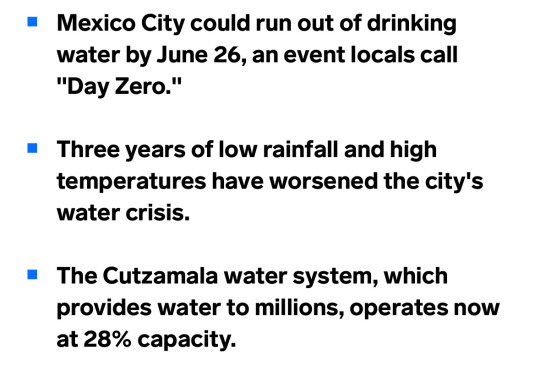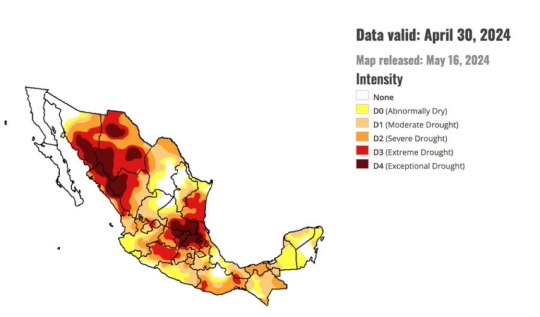#Drought
Explore tagged Tumblr posts
Text





Bird bath revisited. This pair of canyon towhees are backyard regulars and Very Vigorous Bathers.
Cochise County, Arizona, June 2025.
#bird#canyon towhee#bird bath#summer#photographers on tumblr#textless#amadee ricketts#arizona#water#drought#june#video#garden#in the yard#animal camera#game camera#i really like this pair of birds#and i think they are adorable#even though they were the prime suspects in the murder of three baby tomato plants in the spring#we are boys again now
47 notes
·
View notes
Text


Source


Source
#environment#Mexico#news#climate change#government#the left#progressive#twitter post#activism#current events#drought#environmentalism
28K notes
·
View notes
Text
"For the first time in 500 years, the European beaver has been seen in Portugal, a moment that one nonprofit has called “one of the most significant steps in the aquatic rewilding of Portuguese rivers.”
As GNN has reported in the case of the UK, there is no animal other than humans capable of engineering its natural environment at the same scale as the beaver, and it’s clearly this trait which has Portuguese ecologists jumping for joy.
Extinct in the small Iberian country since the 15th century, this large rodent has recently been reintroduced and restored in various parts of Portugal’s large neighbor. Gradually, signs began to appear that the beaver (Castor fibre) was progressively inching closer to Portugal, until recent camera trap footage confirmed the animal’s presence in the country.
“We’ve been on the lookout for this breakthrough for a few years now, and now we’re thrilled to confirm its return. The beaver is a natural ally in restoring the health of our rivers and wetlands and has a fundamental role to play in our river ecosystems,” says Pedro Prata, Team Leader at Rewilding Portugal.
Through its constant activity building dams, beavers transform landscapes into watery paradises for small fish, amphibians, invertebrates, insects, and birds. Their damning of rivers diverts water flow in various different directions, cuts channels for floodwater, and creates ponds and wetlands.
“We’re talking about a species that provides ecological services that no modern equipment can replicate with the same efficiency and scale, without costs and bureaucracy that can never be overcome. The beaver improves water quality, creates refuges for other species and helps us fight phenomena such as drought and fires,” emphasizes Prata.
Portugal suffers from both drought and wildfires, which the beaver’s impact can help prevent through the increased water retention in dryland soil, while the wetter lands beaver dams create act as natural fire breaks.
Beavers don’t only live in the forest, they will happily transform a desert river as well.
Rewilding Portugal, in an article celebrating the animal’s return, detailed how they have long since anticipated this arrival, and informed the relevant ecological authorities to prepare for the disruptive effects which beavers bring hand in hand with the positive ones.
France, Germany, Sweden, and Switzerland have all had to cope with the occasional dam-bursting flood, or an agriculturalist complaining about their riverside plantations being damaged, or someone getting their trees gnawed down. They cope with it in different ways, which Rewilding Portugal say is a worthwhile accommodation for the benefits the beavers bring.
Previously, GNN reported that Rewilding Portugal have reintroduced European wood bison into the Greater Côa Valley ecosystem. As the beaver does in water, the bison does on land: engineering the landscape into a biodiverse and resilient patchwork of micro-ecologies."
-via Good News Network, June 18, 2025
#beaver#beavers#portugal#rivers#riverine#ecosystem restoration#europe#eu#wildfire#drought#good news#hope
935 notes
·
View notes
Text


FP of Drought is very interesting
1K notes
·
View notes
Text
another drought cover i made

734 notes
·
View notes
Text

191 notes
·
View notes
Text
From the article:
“We really kind of refer to this as our third aqueduct,” says John Bednarski, an interim assistant general manager at the Metropolitan Water District of Southern California — a powerful agency, as the largest wholesale provider of water in the nation and owner of the Colorado River Aqueduct. The “third aqueduct” Bednarski is referring to is not another man-made appendage stretching to the Colorado River Basin or into Northern California but rather a project that’s designed to stay local — and sustainable: Pure Water Southern California would recycle wastewater, treat it and produce 150 million gallons of water each day, accounting for about 10 percent of the agency’s local water demands, according to Bednarski. “So it’s going to be a major contributor,” he says. [...] The L.A. Department of Water and Power is pursuing a similar recycling project. And in 2022, 26 cities and wholesale water providers that pull from the Colorado River wrote a memorandum of understanding committing to focusing on water recycling and reuse. The signatories, including Metropolitan, often point to Las Vegas as a model for recycling wastewater to reduce its total Colorado River use and increase the amount of water available for use. Nevada has long faced scarcity; of all the states, it receives the smallest share of the river: just 1.8 percent of all the water rights. By treating and reusing nearly all of its indoor water, the Las Vegas water purveyor effectively uses the same water over and over, expanding its supply. Now Las Vegas officials, along with Arizona water managers, are looking to the Pure Water project to further shore up supplies on the Colorado River. Their thinking: If Metropolitan can reduce its Colorado River use, its unused water could flow to Nevada and Arizona, providing a needed boost in an era when there is little to spare. In that way, water recycling projects in one area can have consequences across watersheds."
#wastewater recycling#water conservation#resource management#climate resilience#climate change#global warming#climate change resilience#renewable resources#water resources#drought#environment#good news#hope#solutions#climate solutions
187 notes
·
View notes
Text

A creek called Sober’s Run. So many rocks visible because of our long drought. But my imagination sees a face in it looking at me kind of cutely.
261 notes
·
View notes
Text

Three Generations of Texans (Now Drought Refugees). c. 1935
Photo: Dorothea Lange
82 notes
·
View notes
Text
WEATHER MODIFICATIONS “CONSPIRACY” NO MORE
#weather#floods#heat waves#weather modifications#cloud seeding#weather control#he who owns the weather controls the world#hurricanes#tornadoes#storms#drought#organised crimes#destruction#fear
170 notes
·
View notes
Text

Dry Lightning (Red Sun IX)
Gouache on paper, 8x10”
2023
754 notes
·
View notes
Text







So many birds! It's been incredibly dry, and every single creature is looking for water. So the backyard bird bath has been crazy with birds, and I especially like this cardinal pair that comes by every day. They are almost always within calling distance of one another, scratching for insects together, hanging out by the water, and singing in the mesquite trees.
Cochise County, Arizona, June 2025.
#bird#cardinal#arizona#water#photographers on tumblr#textless#amadee ricketts#bird bath#in the yard#garden#summer#june#drought#video#animal camera#game camera#shadow
108 notes
·
View notes
Note
https://www.instagram.com/reel/DEnlQVRyeS0/
Gina , a good post to share about AI . Especially in concern with Water scarcity.
Yeah, I found out about the water usage somewhat recently. I had no idea. It’s awful to think about (especially given the current state of Los Angeles).
I also wholeheartedly agree with her caption about using our own brains instead of relying on AI. It’s a terrifying reality we’re headed for if people continue in the direction they’re headed.

49 notes
·
View notes
Text
"In a degraded and semi-arid farming area in India, simple science-driven changes to the landscape have colored the horizon, and a village’s fortunes, with green.
In the Latur district in the central western state of Maharashtra, 40 years of erratic rainfall, groundwater depletion, soil erosion, and crop failures have impoverished the local people.
In the village of Matephal, the International Crops Research Institute for the Semi-Arid Tropics (ICRISAT) launched a project in 2023 that aimed at addressing these challenges through integrated landscape management and climate-smart farming practices. [Note: Meaning they've achieved this much in just two years!]
Multiple forms of data collection allowed ICRISAT to target precise strategies for each challenge facing the 2,000 or so people in Matephal.

Key interventions focused on three critical areas: water conservation, land enhancement with crop diversification, and soil health improvement. Rainwater harvesting structures recharged groundwater around 1,200 acres, raising water tables by 12 feet and securing reliable irrigation. Farm ponds provided supplemental irrigation, while embanking across 320 acres reduced soil erosion.
Farmers diversified their crops, converting 120 or so acres of previously fallow land into productive farmland with legumes, millets, and vegetables. Horticulture-linked markets for fruits and flowers improved income stability.
Weather monitoring equipment was also installed that actively informed sustainable irrigation practices.
“It is a prime example of how data-driven approaches can address complex agricultural challenges, ensuring interventions are precise and impactful. Matephal village is a model for other semi-arid regions in India and beyond,” said Dr. Stanford Blade, Director General-Interim at ICRISAT.
Farmers actively participated in planning and decision-making, fostering long-term commitment.
“This ICRISAT project improved yields, diversified crops, and boosted incomes. It also spared women from walking over a kilometer for drinking water, now available in the village for people and animals,” said Mr. Govind Hinge of Matephal village.
Looking ahead, ICRISAT writes it wants to use Matephal as a case study to scale these methods across India’s vast and drier average. As Matephal’s fields flourish, the village is a testament to the power of collaboration and science in transforming lives and landscapes."
youtube
-Article via Good News Network, March 3, 2025. Video via International Crops Research Institute for the Semi-Arid Tropics (ICRISAT), February 26, 2025
#india#tropics#maharashtra#farming#agriculture#sustainable agriculture#water scarcity#drought#farmers#good news#hope#Youtube#video#climate crisis#climate action#climate resilience
737 notes
·
View notes
Text
Australia should prepare for “megadroughts” that last more than 20 years and will worsen due to human-induced global heating, new research has found. Megadroughts are exceptionally severe periods of below average rainfall that last decades. Climate modelling by the Australian National University, published in the journal of Hydrology and Earth System Sciences last week, found droughts spanning more than two decades have occurred in Australia over the past millennia and reoccur every 150 to 1,000 years, depending on the modelling used.
Continue Reading.
155 notes
·
View notes
Text
by the way i do drought art



133 notes
·
View notes